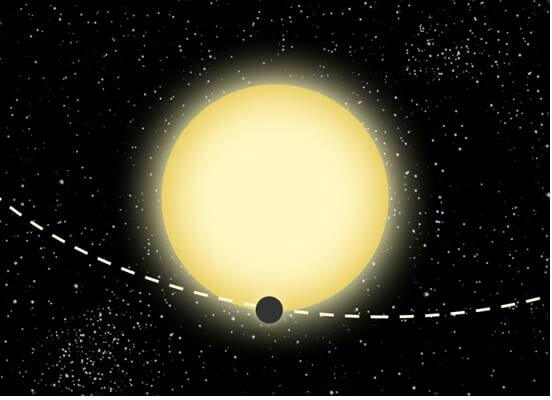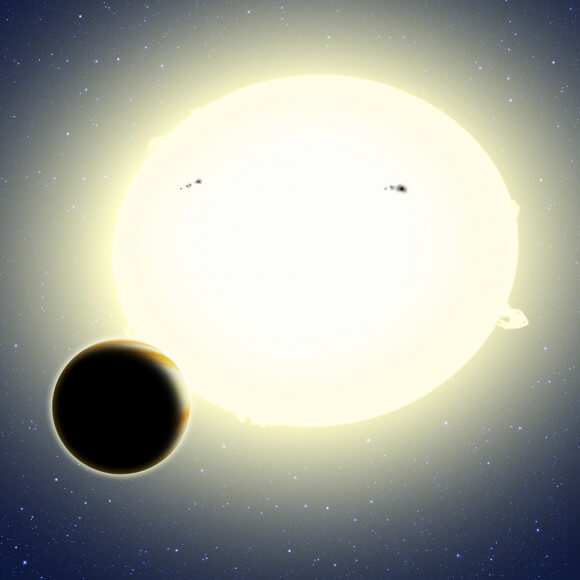A team of astronomers from Tel Aviv University and the Center for Astrophysics shared with Harvard University and the Smithsonian Institute (CfA) announced the discovery yesterday

A team of astronomers from Tel Aviv University and the Center for Astrophysics jointly with Harvard University and the Smithsonian Institute (CfA) announced the first discovery of a planet outside the solar system using a new method based on Einstein's theory of relativity. The new planet, Kepler-76b, is referred to by the team as "Einstein's planet"
For the past two years, Professor Zvi Maza and his PhD student Simhon Feigler from Tel Aviv University have been searching for planets using a new method. They probe the light intensity of tens of thousands of distant suns to find periodic changes caused by invisible planets orbiting them. The planets cause changes in the intensity of light by three effects:
The first effect stems from Einstein's theory of relativity and causes the distant sun, which appears as a star in the night sky, to direct part of its light towards the viewer as it moves towards us. As a result the intensity of the light rises and falls as the sun makes small movements caused by the star planet around it. The discovery of planets using this effect was proposed back in 2003 by Avi Leib and Scott Gowdy. Leib is the head of the Department of Astronomy at Harvard University who also serves as a Sackler Professor by special appointment at Tel Aviv University.
The second effect stems from the fact that the distant sun is stretched into an egg-like shape due to the tidal force exerted on it by the planet surrounding it. As a result, the same sun appears brighter when we observe it from the side, due to a larger surface area, and less bright when the "pointed" side is facing us.

"Einstein's planet," officially known as Kepler-b76, is a "hot Jupiter" that orbits its star every 1.5 days. Its diameter is about 25 percent larger than that of Jupiter and it weighs twice as much. This artist's impression of Kepler-76b shows it orbiting its host star, which is warped by the tides into a slight football shape (in the drawing the phenomenon is shown in a deliberate exaggeration to understand the phenomenon). The planet was discovered using the BEER algorithm, which looked for changes in the star's brightness due to the planet's transit as well as a relative ellipsoidal orbit as seen from Earth. Illustration: David A. Aguilar (CFA)
The third effect comes from the light radiation of that sun reflected by its planet. Since the brightness changes are very small, the three effects can only be detected from observations made by telescopes in space. The team from Tel Aviv University, supported by an advanced grant from the European Research Council (ERC), analyzed the data of more than one hundred thousand stars observed by NASA's Kepler space telescope, and looked for the relativistic effect in combination with the two other effects .
When a candidate for a planet is discovered, an international collaboration begins with the team of Dr. Dave Latham (Dave Latham) from the CfA, which also includes Dr. Lars Buchhave, for spectroscopic observations from the ground, in order to verify the existence of the planet
On May 2012, 76, Feigler and Maza noticed the three effects in one of the stars observed by Kepler. Following this, observations were made by Dave Leitam and his team at the Observatory in Arizona, as well as by Lev Tal-Or, another PhD student from Tel Aviv, at the Observatory in Provence, France. The observations from both telescopes confirmed without a doubt the existence of the planet, now called Kepler-XNUMXb.
The team, which includes Feigler, Tal-Or, Maza, Leitam and Bohaev, announced the discovery last week in an article to be published in the scientific journal The Astrophysical Journal.
The planet Kepler-76b, which is in the constellation Cygnus at a distance of about two thousand light years from us, has twice the mass of Jupiter, and orbits very close to its sun, with a cycle time of one and a half days. Its proximity to the Sun apparently causes it to be locked by tidal forces, so that one side of the planet faces the Sun all the time. This side of the planet is heated by its solar radiation to a temperature of about two thousand degrees Celsius.
While carefully examining the star's brightness data, the research team discovered strong evidence that the heat absorbed by the planet's atmosphere was carried by a strong wind current to a distance of about 15,000 km. This phenomenon was previously observed only in the infrared range, by NASA's Spitzer Space Telescope. This is the first time such a wind stream has been observed in the visible light field on a planet outside the solar system. The study of such wind currents is very important for understanding the reaction of the planet's atmosphere to very high intensity radiation.
All the planets found so far with the help of the Kepler spacecraft data were discovered because their orbit creates an eclipse of the distant sun that they orbit. The special feature of the detection method developed by Feigler and Maza is that it is also possible to detect planets whose orbit does not create an eclipse. "The irony is that Kepler-76b's orbit actually creates a small eclipse that occurs on the rim of its sun," Feigler says. "This is why the system was initially classified as a double star. Only through the discovery of the three effects were we able to identify that it really is a planet."
"This is the first time that this aspect of Einstein's theory of relativity has been used for the purpose of discovering a planet," says Prof. Maza, who is also a member scientist of NASA's Kepler space program. "We've been looking for this elusive effect for over two years, and now we've actually found a planet with it! It's amazing that Leib and Gaudi predicted this more than a decade ago. Professor Shay Zucker from Tel Aviv University, a former PhD student of mine, drew my attention to this effect. At first I didn't think the effect was detectable, but later I was captivated by the idea. Fortunately, we received the support of the European Research Council for the purpose of carrying out the research, and we also collaborated with Dave Laitham who believed in the project and continued to make observations of wrong candidates that we forwarded to him at the beginning of the search. We finally discovered Kepler-76b! It's really a dream come true."
"This discovery proves the ability of the new detection method," says Feigler. "We hope to find many more planets using the same method. All of this is possible thanks to the high quality of data that NASA collects with the Kepler spacecraft for more than 150,000 distant suns."
The research was supported by: European Community's Seventh Framework Program (FP7/2007-2013) ERC advanced grant no. 291352 – BEAMING.
The observations in France were made possible thanks to the European association OPTICON, which enables the sharing of observation time in European telescopes between astronomers. OPTICON is supported by the European Community's Seventh Framework Program (FP7/2007-2013)

10 תגובות
Yehuda:
I didn't say the article was about dark matter but I'm sure you can understand the connection (especially since I explained it).
To Michael
I did not see that the article deals with dark matter and do not understand what the connection is. I agree with you that the article is not clear
Good Day
Sabdarmish Yehuda
Indeed, a very tiny addition that would fit in one case out of a hundred thousand. I don't think it's anything, it certainly won't be useful in finding tiny Earth-like planets. That's my opinion.
Good night
Sabdarmish Yehuda
Some notes:
1. I guess there are a few other people besides me who are not comfortable with how well they understand the story.
a. Where is the light of the planet reflected and how does it affect (after all, we are trying to talk about something that is not an eclipse. Is it light that comes out of the sun and hits the star and is reflected back towards us? This is my guess, but it was not stated explicitly and in the same news in the "Haaretz" newspaper they said that it is light that is reflected back towards the sun)
b. How does the movement of the star increase the intensity of the light? We know the Doppler effect, but it is not new, so it is clear that it is something else.
c. These questions might have been answered if, in addition to the article in Hebrew, the spokeswoman of the university from France had a link to the scientific article describing the research. Such links are almost always missing from university press releases, which is a shame.
2. Whoever complains that the planet in question can also be discovered in other ways would certainly present the opposite complaint if it were not possible to discover it in other ways.
I assume that everyone here is following the discussions on the question of the existence of dark matter and some of you probably remember that I said that this matter is discovered in exactly the same way that some of the planets in the solar system and beyond were discovered.
The argument raised against dark matter is exactly of the type "why do you say it exists - you only discovered it by method A and not by method B).
This claim is not true in relation to the dark matter which is revealed to us by several methods in a compatible way, but it is clear that the more the independent methods of the revelation of something multiply, the more our faith increases - both in the existence of that "something" and in the reliability of the discovery methods.
In this sense - the fact that the planet can also be discovered using the eclipse method is a great blessing because it shows us that the new method does indeed discover planets and that it is not something that requires the development of a new cosmology as required by the dark matter theorists.
In addition to this - it turns out that the new method (which, as mentioned - is still unknown to me) did add information to the discovery because with the eclipse method they were unable to determine whether it was a planet or a double star (again - an explanation of how the new method differentiates between a planet and a double star really wouldn't have hurt us)
Sabdarmish Yehuda
This new method is an addition to the existing methods. Although it is more suitable for discovering large planets, it has 2 advantages: there is no need for the planet to pass across the face of the star, and there is no need for such a precise measurement of the star's speed.
A hundred thousand stars were examined and one large planet was found which in fact could also be found using the eclipse method. It doesn't seem to me that this is a good method for discovering planets. Even in our solar system, where relativistic effects are tested under optimal conditions of a gentle solar eclipse, the magnitude of the change in location of a distant star is about one arc second. All the other phenomena with the help of which planets are discovered are much more significant.
How much the effects amplify each other.
To what extent does this increase the ability to detect planets in terms of distance from Earth / distance and orbit of the planet from its star / discoveries of new planets in the range that have been discovered to date but not in the eclipse.
Thanks, it's a shame it's hot there